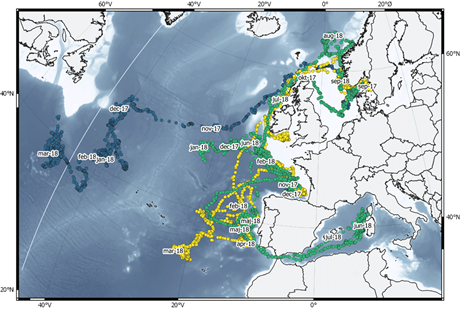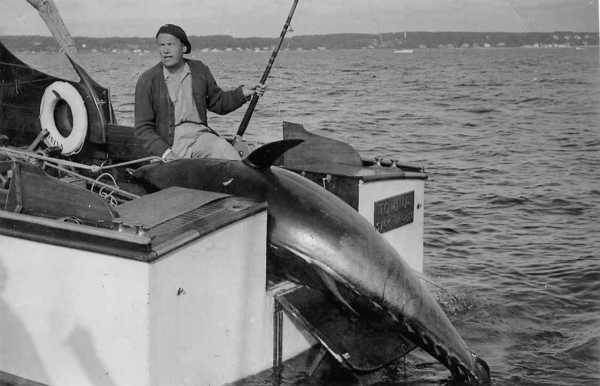The first results from the tagging of the Atlantic bluefin tuna visiting Nordic waters show that the giant fish make extensive migrations in the Atlantic Ocean and that the same tuna return to Nordic waters every year.
The majestic Atlantic bluefin tuna used to migrate to Nordic waters to feed in late summer and autumn, but has practically been absent from the Nordic waters of Skagerrak, Kattegat and Øresund since the early 1960s. Giant tuna is highly prized by anglers due to their size and power. Affectionately referred to as the blue-yellow torpedo in angling communities, Atlantic bluefin tuna can attain a weight of up to 700+ kg. Tuna is also a target species in commercial fisheries and is sold at very high prices all over the world.
Scientists at DTU’s National Institute of Aquatic Resources (DTU Aqua) and SLU’s Institute for Aquatic Resources (SLU Aqua) have—in collaboration with The International Commission for the Conservation of Atlantic Tunas (ICCAT) and experienced anglers—worked together over the last few years to catch, tag and release Atlantic bluefin tuna with advanced electronic tags.
Now the first data from the so-called pop-up satellite tags (PSAT) has been published in the journal ”Scientific Reports”.
Download paper on behaviour of the Atlantic bluefin tuna from Scientific Reports
Data from the pop-up satellite tags (PSAT) are used to investigate the fish’s migration and behaviour. The results show that ”Nordic” Atlantic bluefin tuna undertake long migrations in the Atlantic and that the same tuna return to Nordic waters the year after (Figure 1). Two tags from returning tuna were picked up by the scientists, at almost the same location they were tagged.
Figure 1. Three examples of migration tracks of large Atlantic bluefin tuna tagged in Skagerrak in 2017, with monthly notations along the track. The yellow and green tracks show Atlantic bluefin tuna returned to Skagerrak one year later, while the blue surfaced prematurely due to a tag malfunction. Click on the figure to see larger version.
When the tags are recovered, more detailed data are available and can be used to further investigate specific behaviours, like spawning (e.g. timing and number of events). So far Atlantic bluefin tuna spawning grounds have usually been identified by direct observation. But by coupling spawning behaviour to specific locations from the tags, the scientists have now an alternative method to reveal potentially unknown spawning areas for which there has been strong indications in recent years (Figure 2).

Figure 2. Section of detailed depth and temperature data and migration track from Atlantic bluefin tuna showing spawning behaviour in the Mediterranean. Atlantic bluefin tuna is shown to spawn at night and make a series of fast 50-70 m dives and ascents, presumed to be courtship behavior (left panel). Identified spawning events are shown in purple, pink, black and yellow colors (right panel), with different colors showing spawning events occurring on different days. This area is already known as an area of Atlantic bluefin tuna spawning.
More knowledge about the Atlantic bluefin tuna is important to understand their biology, so that scientists can provide better advice for the sustainable management of this important resource to hopefully ensure that the tuna will continue to visit Nordic waters.
Learn more
By Kim Aarestrup, Henrik Baktoft, Kim Birnie-Gauvin, Brian MacKenzie and Anders Koed, DTU Aqua. National Institute for Aquatic Resources
Historical documentation shows large Atlantic bluefin tuna were abundant during summer and autumn back in the 1920s-1960s in Nordic countries. They were subject of a large commercial fishery from Skagen Harbour, as well as a very famous sports fishery in Øresund.

Angler in Øresund with landed Atlantic bluefin tuna (www.tunaclub.dk).